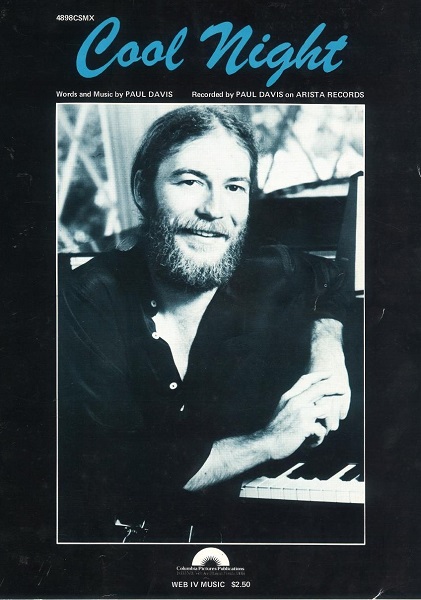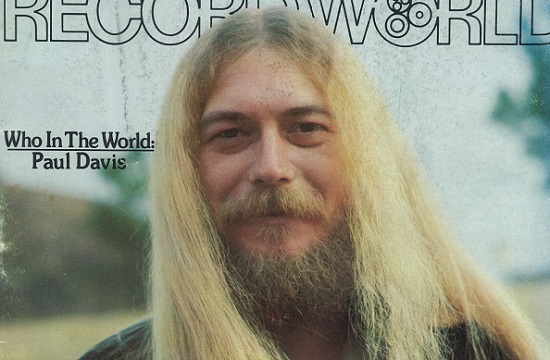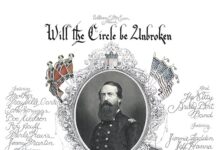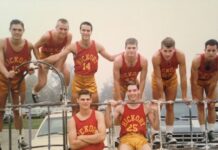Photos Courtesy of Ed Seay
His name is somehow synonymous with yacht rock but don’t let this misnomer fool you. The late, great Paul Davis should really be considered a disciple of the legendary Harry Nilsson.
Like Nilsson, Davis was an earnest singer-songwriter at his core who, despite disinterest in performing live, spun his original songs into musical gold both as a solo performer and as a hitman for other contemporaries. At different microcosmic moments in pop music history, Davis would somehow appear, disappear and then reappear again, replete with a wonderfully silky tenor voice that seemed wholly incongruous to his Meridian, Mississippi roots and style.
“He talked real slow and real southern,” says longtime friend and producer Ed Seay. “You would hear that but then you’d hear his music and his great voice, and you’d day, ‘Wait a second — is that the same guy?”
Let’s backtrack to Spring 1977 when the affable blonde and bearded longhair took a straight-from-the-heart ballad called “I Go Crazy” all the way to Number 7 on the Billboard Hot 100. What makes this track stand out is not necessarily its composition — which is catchy and sincere — but the fact it took its sweet time climbing the charts and slowly tumbling back down; a then record 40 consecutive weeks total. Until this point, Davis had only skimmed the charts periodically since 1970, securing two Top 40 songs along the way — “Ride ‘Em Cowboy” and “Superstar.”
Without outside encouragement and listeners, according to Seay, “I Go Crazy” would have been destined for Lou Rawls’ discography. The soul dynamo had nearly topped the singles chart a year earlier with his seductive behemoth “You’ll Never Find Another Love Like Mine.” It would be Davis’ manager Ilene Burns (wife of Bang Records founder and impresario Bert Berns) who would set him straight.
“At that point Paul was kind of frustrated at being a recording artist,” Seay told me. “He came over to my apartment and he played it on keyboard and it was great. Ilene, when she found out he wanted to give it to Lou Rawls, basically said, ‘You ain’t giving that to Lou Rawls! Get back there and make me a record!’”
With “I Go Crazy” as its penultimate track, Davis would release his fifth album Singer Of Songs, Teller Of Tales. The album would also boast another Top 20 hit single for Davis, “Sweet Life,” a song that would stylistically influence both his most successful album and its eponymous hit single. It would be another couple of years before another Meridian native took the music world by storm — folk icon Steve Forbert of “Romeo’s Tune” fame.
Davis’ next album — a 1980 self-titled effort — would hurl him full-throttle into the new decade as keyboards and sentimentality gave way to synthesizers and sleeker production. A strong proponent of musical technology, Davis loved to tinker with new instruments and sounds, Seay recently recalled, even going so far as to own a Synclavier II. While the album wouldn’t do too much chart-wise, it does contain several classic Davis songs in my book, including “Do Right,” “Cry Just a Little,” and “All the Way.”
Davis would be more than 10 years into his career when he would hit his critical and commercial apex with the seminal 1981 album Cool Night. Recorded over four months, the bulk of the album was devised largely by Davis and Seay themselves. Following a “layer cake” format, the duo would bring in musicians as needed to augment Davis’ compositions and enhance songs from the ground up.
“Cool Night,” an apparent staple of the yacht rock genre, would peak at Number 11 on the Billboard Hot 100 in January 1982. On the adult contemporary chart, it messed the top spot by one notch.
“It was kind of a play in his mind off the title of Kool & the Gang’s “Too Hot,” Seay said. “He said, ‘OK, I’m going to make a song called “Cool Night.”’”
Side note — this song is not to be confused with yacht rock masters Pablo Cruise, who released a track called “Cool Love” in 1981. That song would reach a peak of 13, becoming the group’s fifth and final Top 40 hit. Nor is it “Cool Change” by the Little River Band, another yacht rock notable from 1980.
Cool Night the album marks a significant turning point for Davis, as he would release the album on Arista — helmed by music mastermind Clive Davis. It would be the latter’s industrial wizardry that would take the album in unexpected directions, Seay told me.
“One thing Clive was real big on was modulations. If you think about (“Cool Night”); if you think about Dionne Warwick songs; if you think about Barry Manilow songs, they always had modulations,” he said. “You can’t say he was wrong with as many successes as Clive had over his career. But it did cause us one little problem because we had flown the harmonies in on the second chorus and then [when] we got to the modulation … all our parts are in the wrong key. So, we had to re-sing them for the modulation part.”
Seay adds that when it came to compiling and devising this album — featuring an assured, beaming Davis on its cover — everything took its proper time…until crunch time took place.
“Paul was not a fast writer. He would write incredibly good but not real fast. He wouldn’t just dash it out to be done with it,” he said. “We took the time to get it right. At the very end of each album, Paul would push it right up to the edge of drop dead time.”
“Paul taught me how to produce records because he was a very wise man,” Seay adds. “He was the one who taught me how to make records.”
Cool Night also boasts the biggest hit of Davis’ career — 1982’s “’65 Love Affair.” Containing overdubbed doo-wop harmonies, cheerleader choruses, and Davis’ own “aw shucks”-styled vocals, the track hit a high of Number 6 on the Hot 100. Originally titled “’55 Love Affair,” its title was changed per Clive Davis’ request after thinking it dated Davis more than necessary.
“It was kind of an accomplishment because we weren’t from New York, we weren’t from LA, we weren’t from any of the pop areas. In a way, it worked for us because a lot of times if you’re in an area and something gets hot, you copy that and then they copy you, so there’s a sameness to the sound. We didn’t really have that to draw from,” Seay said. “It was Paul’s creativity and our production and our sense of harmonies. We weren’t the best players in the world — far from it — but we knew how to make records.”
Simply put, Cool Night is an underrated album, given that it sounds like it could easily be a bookend to the Album of the Year Grammy-award winning Toto IV. “You Came to Me” and “One More Time for the Lonely” are terrific pop songs; “Nathan Jones” is a dynamite cover of the Supremes (post-Diana Ross) classic.
Though Cool Night would prove to be Davis’ most successful effort, the album would mark significant personal changes for Davis. Ultimately forgoing his own albums (thank God iTunes has a bunch of them available), Davis would move to Nashville to offer his services to the country elite as a studio musician and songwriter. This is where his influence deepens further. Consider the fact this is a guy who both played synthesizers on the debut album from supergroup The Highwaymen (Willie, Waylon, Kris, and Johnny), and penned classics like “Meet Me in Montana” — a major country hit for “England” Dan Seals and Marie Osmond.
And, like the aforementioned Nilsson, Davis preferred to accomplish it all from the studio versus a stage.
“He was very happy with the success. He loved that, but he was definitely not a road dog. He wasn’t one of those guys who wouldn’t go out and do a three-year tour. He’d do six gigs and that was a big road tour,” Seay told me. “Under duress he would go out and play. He didn’t enjoy it. I think he was kind of shy, to be honest. You would never know it but as far as to be the center of attention…that wasn’t really what he longed to do. So many people are incredible performers and they live to do that. Paul was not that. Paul would rather write songs and fish.”
Known for his dry sense of humor and amiability, Davis would unfortunately pass away in 2008 from a heart attack at the age of 60. Apart from being a longtime smoker, Davis did not lead “a sickly life” according to Seay, who added prior to Davis’ death, he was working with his friend on new songs for a potential album.
Time will tell if this will ever see the light. I hope it does. I mean if I was going to recommend an artist who epitomized being “a little bit country” and “a little bit rock ‘n’ roll,” you really won’t get much better than this underrated giant. Davis also embodies the best of both worlds in another way, Seay adds, being a great person to be around who also happened to be a great talent.
“I really miss him,” he says, “And most people that knew him miss him because he was definitely one of a kind.”

***
Share your feedback and suggestions for future columns with Ira at vinylconfessions84@gmail.com.




















